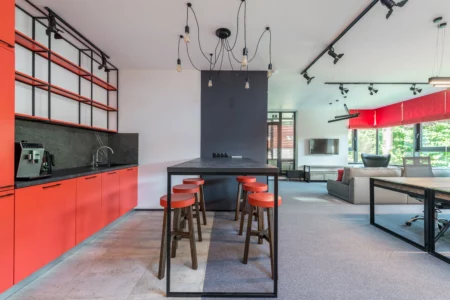 Symmetry and balance are fundamental principles in interior design that contribute to the harmony, visual appeal, and functionality of a space.
Symmetry and balance are fundamental principles in interior design that contribute to the harmony, visual appeal, and functionality of a space.
Whether you’re designing a living room, bedroom, or any other area in your home, understanding and implementing these principles can transform your interior into a more aesthetically pleasing and balanced environment.
1. Visual Harmony
Symmetry refers to the balanced arrangement of elements on either side of a central axis. When applied in interior design, it creates visual harmony and a sense of order. A well-balanced room feels calming and comfortable to be in, making it an inviting space for both residents and guests.
2. Creating Focal Points
Symmetry helps in creating focal points within a room. For example, placing identical furniture pieces on either side of a fireplace or a piece of artwork can draw attention to these central features. This not only adds interest but also provides a clear and organized visual hierarchy.
3. Balanced Lighting
Balancing natural and artificial lighting is essential in interior design. Symmetry plays a crucial role in achieving this balance. Properly placed light fixtures on each side of a room ensure even illumination, reducing shadows and creating a more inviting atmosphere.
4. Furniture Arrangement
When arranging furniture, symmetry can guide your choices. Placing seating or decorative elements evenly around a room fosters a sense of equilibrium and makes it easier for people to navigate the space. It also promotes conversation and social interaction by creating cozy seating areas.
5. A Sense of Proportion
Balance in interior design is not just about symmetry; it’s also about proportion. Balancing the size and scale of furniture and decor items ensures that they fit seamlessly within the room. Oversized or undersized elements can disrupt the visual flow and make the space feel uncomfortable.
6. Personal Expression
While symmetry and balance are essential principles, they can also be tailored to reflect your personal style. You can choose symmetrical elements that resonate with your tastes and preferences, allowing you to express your individuality while maintaining overall harmony.
Incorporating symmetry and balance into your interior design can significantly enhance the beauty and functionality of your living spaces. While adhering to these principles, don’t forget to infuse your personal style to create a space that reflects your unique personality and preferences. Achieving symmetry and balance is the key to a well-designed, harmonious, and aesthetically pleasing interior.
Picture Credit: Pexels



